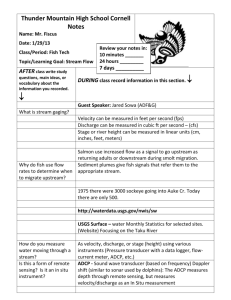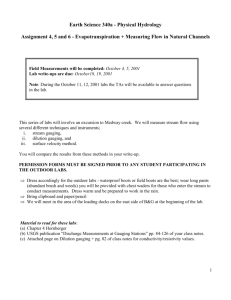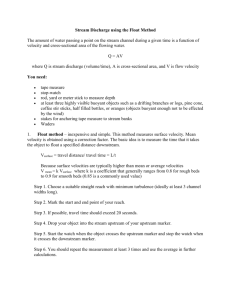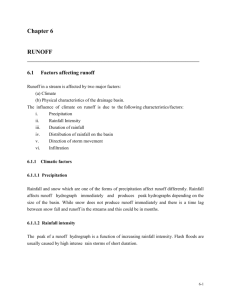Streamflow Measurement (Field Handout)
advertisement
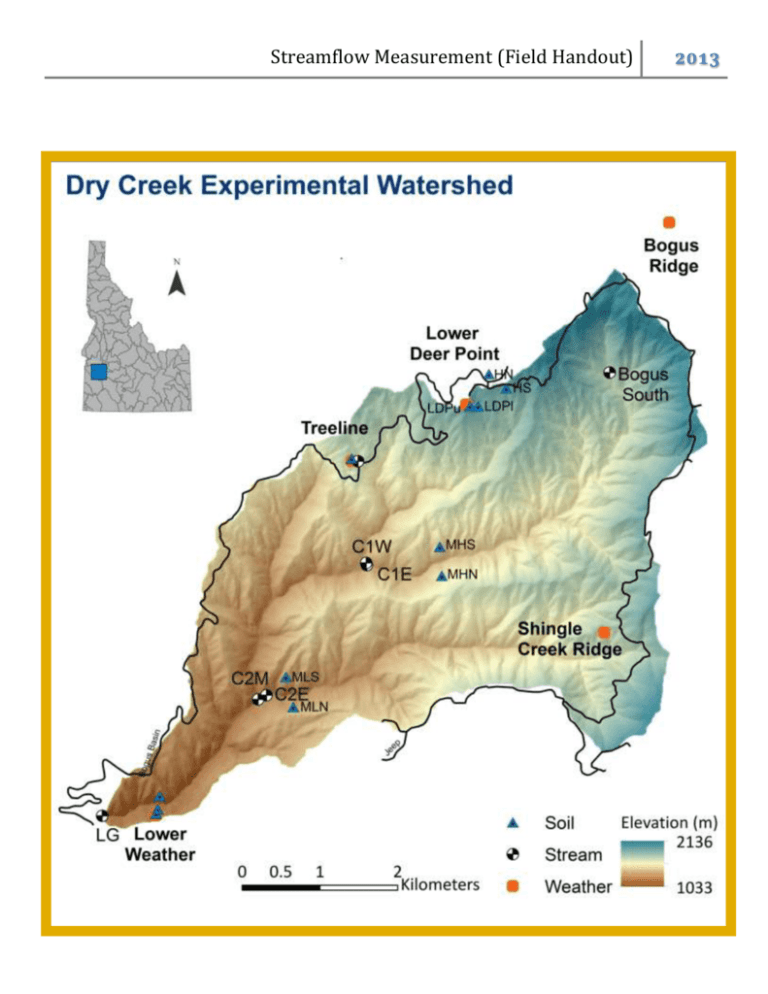
Streamflow Measurement (Field Handout) 2013 Goal The goal of this project is to produce annual hydrograph(s) for the Dry Creek Experimental Watershed (DCEW). Students will 1. 2. 3. 4. Measure discharge near the Dry Creek Lower Gauge site using the Velocity-Area method. Generate a rating curve from stage-discharge data. Create a hydrograph from stage data and a rating curve. Answer discussion questions provided here or assigned by instructor. Background Producing a continuous hydrograph (record of discharge) involves obtaining a continuous record of stage, making discharge measurements over a range of stages, establishing and maintaining a relation between the stage and discharge, and applying the stage-discharge relation to the stage record. A. Instantaneous Streamflow Measurement Streamflow (Q), also called discharge is calculated by multiplying the water velocity (V) and the stream's cross sectional area (A): 3 𝑄 = 𝑉 ∙ 𝐴 [𝐿 ⁄𝑡] (1) The area is simply the width (W) of the river times the average depth (D). Because depth and velocity change through any cross section, several measurements must be made. In the velocity-area method, a stream gauger splits the stream into several cells and measures W, D, and V in each cell, calculates Q in each cell, then adds up all the cells to get the total Q according to Equation 2: The United States Geological Survey recommends 𝑁 (𝑋𝑖+1 ) − (𝑋𝑖−1 ) 𝑄 = ∑ 𝑉𝑖 𝐷𝑖 [ ] 2 (2) 𝑖=1 Figure 1 Schematic illustrating the velocity-area measurement method 20 cells in a cross section. The stream gauger stream discharge calculation; dashed lines delineate individual subsections bound by measurement stations, numbered consecutively i=1, 2 …N. Right moves across the stream measuring the distance left edges of water (REW & LEW) are defined for the gauger facing from the bank to keep track of width, and takes a and upstream; sections can be numbered starting on the right or left bank. depth measurement at a station (i), as illustrated in Figure 1. Velocity must represent the average velocity in the vertical profile. The minimum velocity in a profile occurs at the bottom, the maximum occurs near the top. Rather than making several measurements to average, we assume for streams less than 1 m deep that the average velocity equals the velocity that occurs at 60% of the depth measured from the top. After measuring depth of a profile, the gauger places a current meter at 0.6 times the depth to measure the average velocity for that profile. This is commonly done automatically using a top-setting rod. Streamflow Measurement Page | 1 Project Exercise In today’s field exercise, students will measure discharge near the Dry Creek Lower Gauge site using the Velocity-Area method, as described in [Background]. Field Work 1. Measure Streamflow Rate using the Velocity-Area Method On the hike into the field site, the instructor may stop to point out the Lower Gauge station where stream stage is recorded. For some parts of this exercise, it is necessary to know the stage at the approximate time of when the field measurements are made. The instructor will then guide students to a nearby site amenable to group activities. Once at the site, students will divide into teams, each team will be given tools to make the necessary measurements following the procedures below. Record all data for the following steps in table next page or electronic version of the Stream Measurement Handout: a. Select an appropriate cross-section for discharge measurement. b. Stretch the measuring tape across the creek; note the locations of the right water edge and left water edge. c. Based on the width of the stream and the distribution of flow, determine the locations of at least 10 stations in the cross-section for depth-velocity measurements. d. At each station: i. Record the position of the station (location on the tape) ii. Measure depth of water using the top-setting rod iii. Place the velocity meter, mounted on the top-setting rod, at 60% of the depth from the surface iv. Measure the stream velocity according to the instructions for the instrument provided e. Record stage and time. Stage may be provided later by the instructor. f. Compute the discharge using Equation 2 [Background]. This is best done while in the field to check data, but can be done later. Figure 2 Lower Staff Gauge Instructors may also ask students to estimate discharge by a variety other methods including the “stick-float” method or simply intuitive guessing. Classwork Complete the remaining steps by following the instructions online1 2. Develop a rating curve (stage-discharge relationship) 3. Create a Hydrograph 4. Discussion Questions 1 http://earth.boisestate.edu/drycreek/education/streamflowmeasurement/ Streamflow Measurement Page | 2 Site Name: Date: Stage & Time Recorded: Instrument: * Note: Rotations and Time are only used with the Pygmy meter Station ___ Location __ Depth ___ Rotations* ___ Time* ___ Velocity ___ Total Discharge Streamflow Measurement Discharge ___ Comments ft3/s Page | 3

